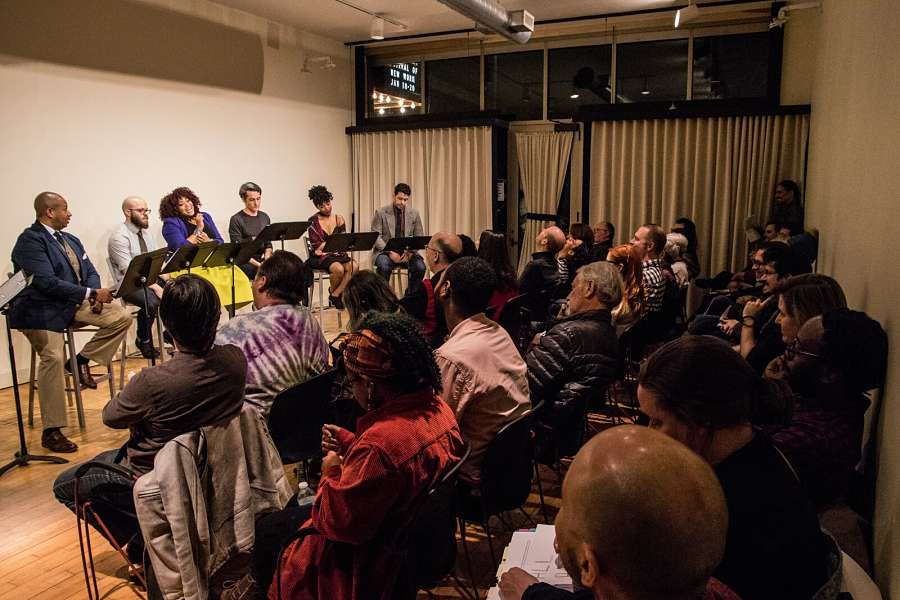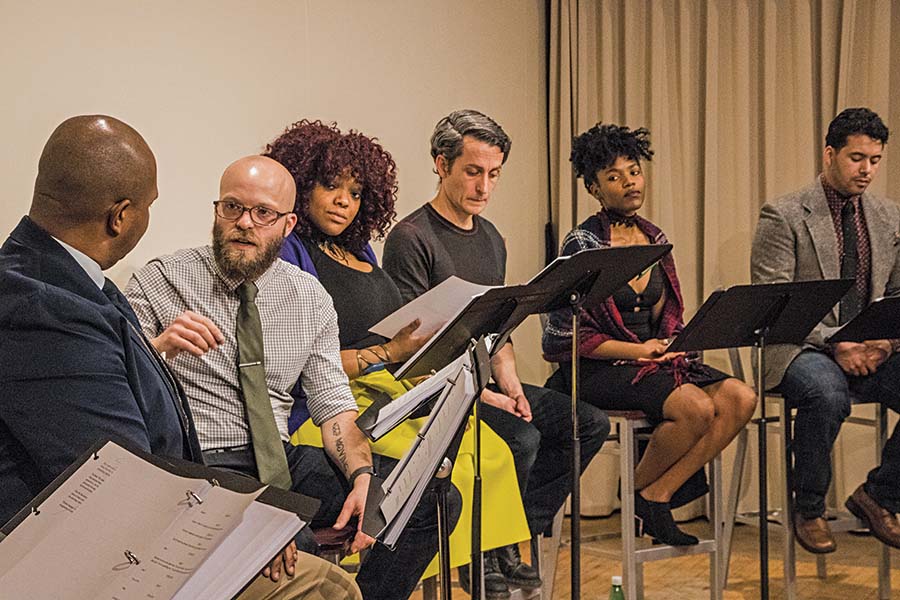Botany knows two paths to fertilization: self-pollination and cross-pollination. The former occurs when a nectar-seeking bee careens around a flower, accidentally kicking up a little dust, so that pollen is transferred from the flower’s anthers to its ovules, and fertilization can proceed to generate seeds.
The latter is a little more complicated. Cross-pollination happens when, flitting flower to flower, the bee imports pollen from one flower’s anthers to a new and different flower’s ovules, making possible unexpected hybrids, or crossbreeds. What can you do? It’s nature’s way.
The National New Play Network, known for its rolling world premiere co-productions—a sort of self-pollination model—recently branched out into something more cross-collaborative as a way to grow new plays under the auspices of its Collaboration Fund program.
NNPN’s pilot project has transplanted three seasoned playwrights with works ripe for cultivation into soils beyond their own gardens. The experiment seeks to explore what artistic or process-oriented benefits and innovations might emerge if three of the network’s core member theatres—Kitchen Dog Theater of Dallas, InterAct Theatre Company of Philadelphia, and Cleveland Public Theatre—daisy-chained their creativity inside a collaborative structure of new-play development.
“Theatre lives with other people,” says Erin Washburn, wearer of many hats at the InterAct company (including that of literary and external relations manager), who took the lead in writing the initial proposal for the Cross-Pollination Project. “It succeeds when minds are pinging off of each other. We don’t do this work in a vacuum, so why should we develop plays in a vacuum?”
NNPN garnered $10,000 to bring Washburn’s idea to fruition, and the program kicked off in January 2018 by sending InterAct playwright James Ijames and his play history of walking to Cleveland for CPT’s Entry Point festival. Then it brought Jonathan Norton and his play a love offering from Kitchen Dog to be workshopped at InterAct in mid-May. It wrapped up (for now) in mid-June by catapulting Lisa Langford and her play Rastus and Hattie (a CPT undertaking) down to Kitchen Dog as part of that company’s New Works Festival.
One of Washburn’s main impulses was to take playwrights out of their familiar place of solitude into new kinds of collaboration. And a key learning for all three cross-pollinating playwrights was that working on familiar material in an unfamiliar setting revealed insights and perspectives on the work previously hidden from their view.
James Ijames, for one, discovered that he’d be wise to reconsider issues of scale, both in terms of size and scope, for his play—formal reconsiderations that have led to an exponential growth of the material previously contained in history of walking.
“The play is more than one play—it’s bigger than what I was allowing it to be,” he says. That insight, he says, was something revealed to him by “doing it in a community that is not my own, with different cultural signifiers.”
“James is beloved in Philadelphia,” explains Kittson O’Neill, former artistic associate of InterAct, who accompanied Ijames to Cleveland. “His career is exploding. When James has a reading, there’s love in the room. But in Cleveland, nobody knew who he was—there was a different level of honesty.”
Ijames had started writing the play during the 2016 presidential primaries, almost as a therapeutic practice to cope with the discourse of presidential politics, which he found “anxiety-inducing” and “surreal.”
“It was political theatre in a way that I’ve never experienced,” he recalls. “In a very intentional way, it moved into a space of, Who can sell the brand better? The election became really personal, about my own preservation. I grew up Christian and still consider myself to be Christian, but lately I find myself asking, ‘Whose cosmology is winning?’”
Part of what Ijames was investigating in Cleveland is how change actually happens, and after a week of working on the play and “taking a big swing at it” in a major rewrite, he found a partial answer. “We have to overcome an aversion to getting things wrong,” he reasons. “Like heirloom tomatoes that look messy, even ugly, there’s something to be said about the mess we’re in—that something good can come of it.”
Just being in the city of Cleveland brought Ijames to another stage of clarity about U.S. history and his walk with it. “There’s too much survival in this country’s history to throw in the towel,” he allows. “I don’t have any tentativeness about that anymore. I want to push back against giving in—that’s actually the work.”
A major revision of a pivotal character was the main takeaway of Jonathan Norton’s three-day workshop experience in Philadelphia, in a transformed script that may never have emerged if the play had been developed in Texas only.
The action of his A Love Offering is propelled by an investigation, by a white brother and sister, into the disappearance of a family heirloom from a Texas nursing home where their father lives. The home is staffed by black women caretakers.
Thanks to feedback from actors during the rehearsal process, Norton came to understand that his portrayal of Josie, the sister character, was too caricatured, and that she was being perceived universally as a bitch. It had never been Norton’s intention for Josie to be seen in that light, and it was the realization that his Philadelphia colleagues saw Josie through a different cultural frame that prompted some major revisions.
“In the South, African Americans have more trust with Southern racists than with Northern ones—we know where we stand and who we’re dealing with,” Norton explains. “In the North, kindness is extended as long as it doesn’t rock the institutional boat.”
“Jonathan’s play is set in Texas, and there are specific Texas things about it,” explained Tina Parker, Kitchen Dog’s co-artistic director and administrative director, who accompanied Norton to Philadelphia. “But you want your play to have life beyond specific cultural understandings. You want to make your play bullet-proof and idiot-proof. You want to go Beckett on that shit!”
The feedback in Philly led Norton to put words in Josie’s mouth that allowed her to be seen as more stable, less overtly hostile, yet still deeply problematic in her assumptions and attitudes.
“There was an incredible level of generosity from the actors,” reports InterAct’s O’Neill, who had been mindful to cast smart, experienced actors. “They were especially willing to advocate for the ideas they strongly believed in.”
Indeed Norton was making changes in the script up until the last half-hour of the workshop. “It’s useful for playwrights to be open-minded,” he figures, “to have good listening skills, not be afraid of criticism, and to be able to discern what’s useful now, what’s useful two months from now, and what’s not useful at all. I love the pushback that happens in the room. I can make the play better.”
Lisa Langford, whose play features two black robot slaves, says she was boarding the plane in Cleveland to fly down to Texas when it occurred to her just where she was headed. “Holy crap, I’m going to the South!” she remembers thinking. “I know a lot of Texans don’t think of themselves as Southerners, but until that moment I’d never thought of myself as a Northerner who’d been sitting up in Cleveland in the snow writing a lot of smack about the South!”
In broad strokes, Rastus & Hattie asks its audiences to contemplate the possibility (or impossibility) of any shared understanding about U.S. history across the boundaries of race. The question is provoked when black friends visiting white friends are served dinner by two black robots, machines that are salvaged prototypes of an actual kitchen appliance developed by Westinghouse in the 1930s. The device, believe it or not, was called “Rastus Robot, the Mechanical Negro.” In the play, Marlene, who is white, inherits two such robots from her father and puts them to use as helpers for the sake of convenience, blithe to her lifelong friend Needra’s shock and hurt.
There’s a scene between Needra and Hattie, the female robot that has been programmed with certain sociological knowledge specific to her time and place, in which Hattie recites a litany of all of the parts of a pig “from the squeal to the peel,” and the ways they can be cooked, including “hog-hoof tea.” Needra, heaving and unable to contain her disgust, cries out: “I’m going to be sick!” The exhaustive pig-parts list actually came from Langford’s aunt, and the play, which explores generational trauma at the cellular level, connects to her own family history.
According to CPT associate artistic director and director of production Beth Wood, who was in Dallas with Langford, “It was inspiring to be in the room. Everybody believed in the play, and there was a palpable energy.”
The moment she arrived in Dallas, Langford met her dramaturg Haley Nelson and director Rhonda Boutté, and they all went straight to the theatre. She says that being in a new environment sparked a special kind of creativity, and that her first night there she was up until after 1 a.m. thinking: “I could do this, I could do that; it could be this way, or that.” Now she had a context in which to develop Hattie—a specifically Southern milieu—and it led to the play’s biggest change.
“There’s a moment,” notes CPT’s Wood, “when the characters jump back in time, originally to the 1920s.” But Haley suggested that it would be more visually powerful, and up the tension and all the stakes, if instead the time jump was to the post-Antebellum period.” Langford’s response to her dramaturg’s idea was, “Let’s try that!” She went back and rewrote the play’s entire second act.
In the new version, Needra and her husband Malik are lost in the woods; lanterns pass by and dogs are heard barking in the near distance. The scenes portraying this regression are some of the play’s most harrowing, as the couple tries to sort out their new reality, wondering if they’re slaves or if they’re free.
“It was such an incredibly smart note, to go back another few decades,” Wood elaborates. “We were in a really extraordinary community of artists; so many of those actors gave great cold reads, which is so important for the playwright, to know that she has it on the page.”
“What I loved about being at Kitchen Dog,” Langford testifies, “was that their audiences gave me feedback as well. It confirmed that there was something important in whatever motivated me to write this. We talk across race sometimes—people don’t really listen to each other, and don’t really know each other. To see people respond to that impulse is really gratifying.”

Initial responses from the first cohort of Cross-Pollination Project theatres are already leading NNPN’s executive director Nan Barnett and her programs manager Jordana Fraider to begin to think about ways in which they can move the project forward, possibly to the rank of NNPN’s primary programs. Programmatically it makes sense to complement the existing programs that facilitate new-play submissions (the New Play Exchange) and new-play production (the rolling world premieres) with new-play development.
“I’m hoping that we’ll soon be trying it again,” Barnett says, “and that this initiative can continue as part of the Collaboration Fund. Of course, now that it’s here, there’s a feeling of ‘Why didn’t it always exist?’ For over 20 years, NNPN has been aiming to suss out what’s the big issue that’s bothering the new play field, so we tried something, and now we’re evaluating whether it solves the need. Does this create that next level of conversation? Can something like Cross-Pollination be the next way of working together in new-play development?”
Adds Fraider, “We’re very interested in the notion of pipeline—we’re always looking for ways to expand the pipeline between regions without relying on filtering the work through the New York theatre scene.”
Like all really good ideas, the Cross-Pollination Project, in retrospect, seems inevitable. “These theatres wanted to work together,” Fraider concludes, “and at the mission level they’re engaged in conversations about social justice and creating social change. It’s both a product of the times and a recognition that theatre makes change in the real world.”
Frances Madeson is a writer based in North Dakota.




